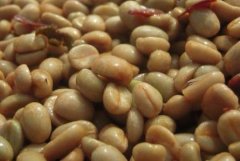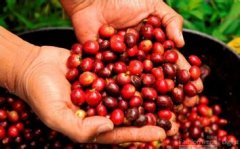A brief introduction to the flavor and aroma characteristics of Burundian coffee with fruit flavor

Londi Coffee bears a striking resemblance to neighboring Rwanda, where coffee from the two countries is often confused. Burundian coffee is mainly grown in bourbon, with traditional wet processing of coffee cherries. Its boutique coffee is characterized by elegant sweetness and bright citrus aromas.
Burundi is a small landlocked country located at the junction of eastern and central Africa, across the Nile and Congo basins, dominated by hills and mountains, with excellent coffee-growing elevations. The history of coffee cultivation in Burundi is not long, its coffee planting industry is carried out entirely in the form of small family farms, there is a great difference in quality, and years of war and social unrest have made its coffee planting industry very chaotic. But I have to admit that it has the potential to produce high-quality coffee.
Burundi Buyendi AA,FWS
There are two major ethnic groups in Burundi, and only about 15 percent of the Tutsi have ruled the country since the 16th century, controlling the civilian population, which is mainly made up of Hutu, plus a very small number of indigenous Twa. This abnormal social structure occupied by ethnic minorities planted the evil seed of national instability and reached its peak in October 1993. Just four months after taking office, Melchior Ndadaye, Burundi's first ever Hutu head of state and the first democratically elected president, was assassinated by a mainly Tutsi-controlled military. The death of Ndadaya led to a comprehensive ethnic conflict in which at least 200000 of the population of both sides were slaughtered, of which 65000 Tutsi were slaughtered to fewer than 5000. The massacre lasted until 2002, when the Tutsi government finally signed an international armistice with four different Hutu rebels, while the ceasefire agreement with the last rebel group, the Forces nationales de Liberation (FNL) (French: Conseil National Pour la D é fense de la D é mocratie-Forces pour la D é fense de la D é mocratie, NCDD-FDD), was signed in Dar es Salaam, Tanzania, on September 7, 2006.
Burundi coffee was introduced by Belgian colonists in 1930. Unfortunately, many of these farms are on the border with war-torn Rwanda, putting pressure on coffee production.
Coffee producing areas in Burundi:
Coffee in Burundi is now grown only on small farms. Almost all coffee produced in Burundi is Arabian coffee beans, while coffee trees in Ngozi are planted at an altitude of more than 1200 meters.
Features of Burundian coffee:
Burundi has the most diverse and successful coffee industry in the world, and has its own characteristics. Burundian coffee is fragrant and has excellent acidity.
Flavor: mellow taste, rich aroma, excellent acidity
Suggested baking method: medium to deep baking
★★: good
Burundian coffee market:
Most of Burundi's coffee products are exported to the United States, Germany, Finland and Japan.
Producing country: Burundi
Grade: AA,FWS
Planting area: Buyendi
Brand name: Buyendi
Treatment method: wet treatment
Appearance: 1dcompany300grgrRAME 16-18SCR
Variety: Jackson bourbon
Note: due to ethnic separatism, the chaos of Burundian coffee has been going on for a long time, with a large number of old and new raw beans mixed together, making this coffee unsuitable for grading. This coffee is rough but mild, and has characteristics similar to Kenyan coffee. The flavor is sweet and fruity, with a slightly spicy finish.
Dry aroma (1-5): not applicable
Wet aroma (1-5): not applicable
Acidity (brightness) (1-10): not applicable
Taste (layered) (1-10): not applicable
Taste (alcohol thickness) (1-5): not applicable
Aftertaste (residue) (1-10): not applicable
Balance (1-5): not applicable
Base score (50): not applicable
Total score (maximum 100): not applicable
Strength / main attributes: medium strong / sweet, fruit flavor, spicy aftertaste.
Recommended baking degree: full city
Contrast: very similar to Kenyan coffee
Important Notice :
前街咖啡 FrontStreet Coffee has moved to new addredd:
FrontStreet Coffee Address: 315,Donghua East Road,GuangZhou
Tel:020 38364473
- Prev

Brief introduction to the treatment method of Grinding degree and Baking degree of Fine Coffee beans in Xipi Waterfall, Uganda
The livelihood of 25% of the population is closely related to coffee production. About 500000 farms grow coffee, but mainly Robster. Robusta accounts for 90% of coffee production, and the remaining 1 is Arabica coffee. Arabica and Robusta harvest only a small amount of Arabica beans in Java from October to February of the following year, and most of them have not been produced since the rust disaster.
- Next

A brief introduction to the History and Culture of the Origin and Development of aromatic Burundian Fine Coffee
Coffee production in Burundi: Burundian coffee is now grown only on small farms. Almost all coffee produced in Burundi is Arabian coffee beans, while coffee trees in Ngozi are planted at an altitude of more than 1200 meters. Characteristics of Burundi Coffee: Burundi (Burundian) has the most diverse and successful coffee industry in the world, and has its own characteristics.
Related
- Detailed explanation of Jadeite planting Land in Panamanian Jadeite Manor introduction to the grading system of Jadeite competitive bidding, Red bid, Green bid and Rose Summer
- Story of Coffee planting in Brenka region of Costa Rica Stonehenge Manor anaerobic heavy honey treatment of flavor mouth
- What's on the barrel of Blue Mountain Coffee beans?
- Can American coffee also pull flowers? How to use hot American style to pull out a good-looking pattern?
- Can you make a cold extract with coffee beans? What is the right proportion for cold-extracted coffee formula?
- Indonesian PWN Gold Mandrine Coffee Origin Features Flavor How to Chong? Mandolin coffee is American.
- A brief introduction to the flavor characteristics of Brazilian yellow bourbon coffee beans
- What is the effect of different water quality on the flavor of cold-extracted coffee? What kind of water is best for brewing coffee?
- Why do you think of Rose Summer whenever you mention Panamanian coffee?
- Introduction to the characteristics of authentic blue mountain coffee bean producing areas? What is the CIB Coffee Authority in Jamaica?

